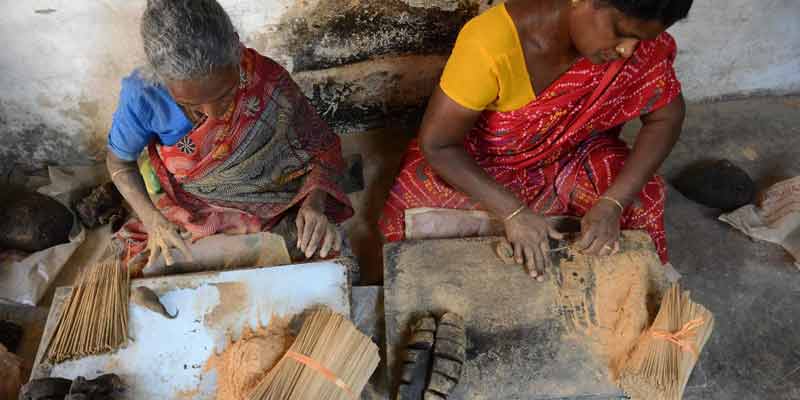- India
- Aug 03
Govt approves new scheme to make agarbatti industry self-reliant
Union Minister Nitin Gadkari has approved an employment generation programme proposed by Khadi and Village Industries Commission (KVIC) to make India self-reliant in agarbatti production.
The programme — Khadi Agarbatti Atmanirbhar Mission — aims at generating employment in different parts of the country and increasing domestic agarbatti production.
The proposal was submitted to the ministry of MSME for approval last month. The pilot project will be launched soon and on full-fledged implementation of the project.
Agarbatti industry in India
The current consumption of agarbatti in the country is approximately 1,490 tonnes per day. However, per day production of agarbatti in India is just 760 tonnes. The deficit is met through imports primarily from China and Vietnam.
The import of raw agarbatti increased from 2 per cent in 2009 to 80 per cent in 2019. In monetary terms, the import of raw agarbatti in India increased exponentially from Rs 31 crore in 2009 to Rs 546 crore in 2019 due to reduction of import duty — from 30 per cent to 10 per cent — in 2011.
This hit the Indian agarbatti manufacturers hard and resulted in closure of nearly 25 per cent of the total units.
In August, 2019, the government imposed restrictions on imports of agarbatti and other similar products amidst reports of significant increase in inbound shipments from countries like China and Vietnam.
It revived hundreds of agarbatti units in Maharashtra, Madhya Pradesh, Uttar Pradesh, Gujarat and several northeast states. It also prompted the local traders to import round bamboo sticks for manufacturing of raw agarbatti. This resulted in an increase in import of bamboo sticks from Rs 210 crore in 2018-19 to Rs 370 crore in the year 2019-20.
In June 2020, the Centre decided to increase import duty on bamboo sticks from 10 per cent to 25 per cent.
KVIC said that, in the next 8-10 months, at least one lakh new jobs will be created in the agarbatti industry.
While 136 varieties of bamboo are found in India, the Bambusa Tulda variety — which is used for making agarbatti sticks — is abundant in the northeast region.
How will the new scheme be implemented?
The scheme designed by KVIC on public–private partnership (PPP) mode.
KVIC will provide automatic agarbatti making machines and powder mixing machines to the artisans through the successful private agarbatti manufacturers who will sign the agreement as business partners.
KVIC has decided to procure only locally made machines by Indian manufacturers which also aims at encouraging local production.
KVIC will provide a 25 per cent subsidy on the cost of the machines and will recover the remaining 75 per cent of the cost from the artisans in easy installments every month.
The business partner will provide the raw material to the artisans for making agarbatti and will pay them wages.
Each machine makes approximately 80 kg agarbatti per day which will provide direct employment to four persons. One powder mixing machine, to be given on a set of five agarbatti making machines, will provide employment to two persons.
The current job work rate for agarbatti making is Rs 15 per kg. At this rate, four artisans working on one automatic agarbatti machine will earn minimum Rs 1,200 per day by making 80 kg of Agarbatti. Hence every artisan will earn at least Rs 300 per day. Similarly, on a powder mixing machine, each artisan will get a fixed amount of Rs 250 per day.
After recovery of the 75 per cent cost, the ownership of the machines will automatically be transferred to the artisans.
Gramodyog Vikas Yojana
On July 30, the MSME ministry approved a programme for the benefit of artisans involved in manufacturing of agarbatti and to develop village industry under ‘Gramodyog Vikas Yojana’.
As per the programme, four pilot projects will be started, including one in the northeast region.
What is the purpose of Gramodyog Vikas Yojana?
As a part of rationalisation exercise, eight different schemes of KVIC are now merged under two umbrella heads — Khadi Vikas Yojana and Gramodyog Vikas Yojana.
Gramodyog Vikas Yojana aims to promote and develop the village industries through common facilities, technological modernisation, training, etc.
It has following components:
Research & development and product innovation:- R&D support would be given to the institutions that intend to carry product development, new innovations, design development, product diversification processes, etc. Engaging professionals and research/scientific institutions may carry out the product design development.
Capacity building: Under the human resource development and skill training components, exclusive capacity building of staff as well as the artisans would be adequately addressed.
Marketing and publicity: The institutions will be provided market support by way of preparation of product catalogue, industry directory, market research, new marketing techniques, buyer seller meet, arranging exhibitions, etc.
Manorama Yearbook app is now available on Google Play Store and iOS App Store

